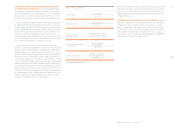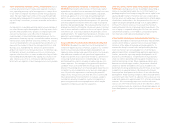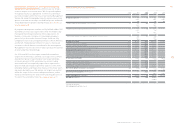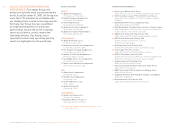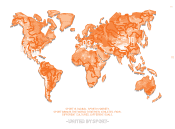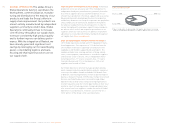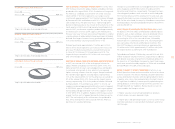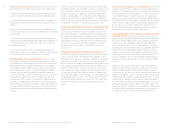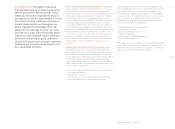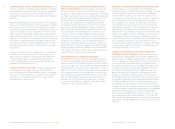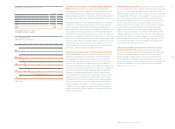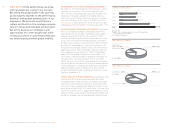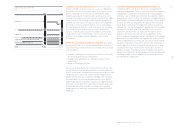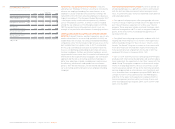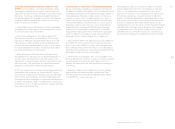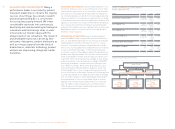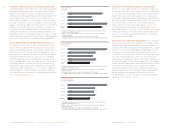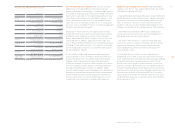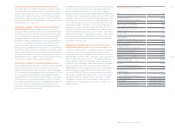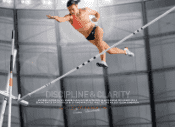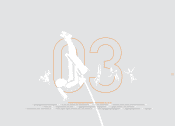Reebok 2007 Annual Report Download - page 71
Download and view the complete annual report
Please find page 71 of the 2007 Reebok annual report below. You can navigate through the pages in the report by either clicking on the pages listed below, or by using the keyword search tool below to find specific information within the annual report.
067
ANNUAL REPORT 2007 --- adidas Group
02
SYSTEM-BASED APPROACH TO MANAGE ENVIRONMENTAL
IMPACTS We have adopted a system-based approach to
managing environmental impacts in our own production facil-
ities and throughout our supply chain. Activities focus on
helping sup pliers establish sound environmental management
systems to best reduce their negative environmental impacts.
We develop guidelines and training programs for our suppliers
using the environmental performance of our own production
sites as examples of best practice. We have mandated the
implementation of environmental management systems at our
core suppliers to ensure continuous monitoring and improve-
ments. In our product creation process, we focus on improving
materials in our products and on tackling pollution in factories.
Our goal is to eliminate polluting materials and processes and
to increasingly utilize sustainable materials instead. To achieve
this goal we have several key initiatives in place such as con-
trolling and monitoring restricted substances and reducing
emissions of Volatile Organic Compounds (VOCs).
CONTROL AND MONITORING OF RESTRICTED SUBSTANCES
Restricted substances are those that cause harm or are sus-
pected to cause harm to human health or the environment.
Our suppliers are required to avoid using restricted sub-
stances. We have specifi ed clear standards that follow the
strictest local regulations and best practice standards for
consumer care and safety in the Group’s policy for monitoring
and control of hazardous substances. This policy is mandatory
for all business partners and is updated regularly based on
fi ndings in our ongoing dialog with scientifi c organizations.
Our standards cover the general requirements for eco-labels
and green seals (e. g. ÖKO-Tex Standard 100, Tox Proof TUV
Rhineland, etc.) for footwear, apparel and hardware products.
Both our own quality assurance laboratories and external
testing institutes are used to constantly monitor material
samples to ensure supplier compliance with these require-
ments. Materials that do not meet our standards and specifi -
cations are rejected.
REDUCING VOC EMISSIONS Volatile Organic Compounds (VOCs),
which are typically found in solvents used in our manufacturing
process, can cause breathing diffi culties and other health
problems for production workers. Therefore, we are committed
to reducing VOC emissions in our suppliers’ footwear factories.
Our efforts focus on nearly all new adidas Group footwear
factories and refl ect the technical synergies of sharing infor-
mation, data and sources on production questions such as
water-based cement systems. At our core footwear suppliers
we measure the exposure and the records taken provide
evidence that workers are not being exposed to dangerous
levels of VOCs. Nonetheless, we remain committed to further
reducing emissions. In recent years, we have made signifi cant
progress. Our athletic footwear suppliers in Asia and Europe
have reduced VOC emissions from 140 grams per pair in 2000
to 20.3 grams per pair in 2007. Our target is an average VOC
emission of 20 grams / pair of shoes.
STRONG SUSTAINABILITY TRACK RECORD REFLECTED IN
INDEX MEMBERSHIPS We appreciate positive recognition
from international institutions and rating agencies, NGOs and
socially responsible investment analysts. They evaluate our
efforts through in-depth analysis of our social and environ-
mental program, including document review as well as inter-
views with employees and management. As a result, adidas AG
has been included in a variety of high-profi le sustainability
indexes. see Our Share, p. 036
NUMBER OF FACTORY VISITS / AUDITS
Internal FLA
2003 1)
2004 1)
2005 1)
2006 2)
200
72
)
1
)
Includin
g
Salomon business se
g
ment
.
2
)
Includin
g
Reebok business se
g
ment.
906 13
954 12
916 14
1,101 43
1,007 15
7
VOC CONSUMPTION 1)
i
n
g
rams per pair o
f
shoes produced
1999 2000 2001 2002 2003 2004 2005 2006 2007
160
1
2
0
80
40
0
1
)
At
y
ear-end.


